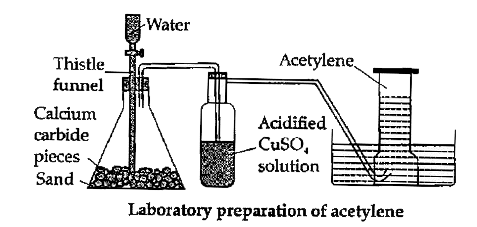Which of the following will show "Tyndall effect "?
(a) Salt solution
(b) Milk
(c ) Copper sulphate solution
(d) Starch solution.
To determine which of the given options will show the Tyndall effect, we need to understand what the Tyndall effect is and which types of mixtures exhibit this phenomenon.
1. Understanding the Tyndall Effect:
- The Tyndall effect is the scattering of light by particles in a colloid or in very fine suspensions. It occurs when light passes through a colloidal solution, causing the light to scatter in different directions.
2. Identifying the Types of Mixtures:
- Salt Solution (a): This is a homogeneous mixture where salt is completely dissolved in water. Since it does not contain suspended particles, it does not show the Tyndall effect.
- Milk (b): Milk is a colloidal mixture, which means it contains small particles suspended in liquid. Therefore, milk will show the Tyndall effect.
- Copper Sulfate Solution (c): Similar to the salt solution, copper sulfate is also a homogeneous solution where the particles are completely dissolved. Thus, it does not exhibit the Tyndall effect.
- Starch Solution (d): Starch solution is a colloidal mixture as well. It contains suspended starch particles that can scatter light, so it will show the Tyndall effect.
3. Conclusion:
- Based on the analysis:
- Options that show Tyndall effect: Milk (b) and Starch solution (d).
- Options that do not show Tyndall effect: Salt solution (a) and Copper sulfate solution (c).
Final Answer:
The options that will show the Tyndall effect are (b) Milk and (d) Starch solution.
---
- The Tyndall effect is the scattering of light by particles in a colloid or in very fine suspensions. It occurs when light passes through a colloidal solution, causing the light to scatter in different directions.
- Salt Solution (a): This is a homogeneous mixture where salt is completely dissolved in water. Since it does not contain suspended particles, it does not show the Tyndall effect.
- Milk (b): Milk is a colloidal mixture, which means it contains small particles suspended in liquid. Therefore, milk will show the Tyndall effect.
- Copper Sulfate Solution (c): Similar to the salt solution, copper sulfate is also a homogeneous solution where the particles are completely dissolved. Thus, it does not exhibit the Tyndall effect.
- Starch Solution (d): Starch solution is a colloidal mixture as well. It contains suspended starch particles that can scatter light, so it will show the Tyndall effect.
- Based on the analysis:
- Options that show Tyndall effect: Milk (b) and Starch solution (d).
- Options that do not show Tyndall effect: Salt solution (a) and Copper sulfate solution (c).
The options that will show the Tyndall effect are (b) Milk and (d) Starch solution.
Topper's Solved these Questions
- IS MATTER AROUND US PURE?BOOK - NCERT ENGLISHCHAPTER - IS MATTER AROUND US PURE?EXERCISE - Questions
1 Videos
- ATOMS AND MOLECULES BOOK - NCERT ENGLISHCHAPTER - ATOMS AND MOLECULES EXERCISE - Exercise
25 Videos
- MATTER IN OUR SURROUNDINGSBOOK - NCERT ENGLISHCHAPTER - MATTER IN OUR SURROUNDINGSEXERCISE - Exercise
26 Videos
Similar Questions
Knowledge Check
Which of the following systems will show Tyndall effect ?
AAqueous solution of sodium chlorideBAqueous solution of aluminium hydroxideCAqueous solution of glucoseDAqueous solution of ureaWhich one of the following will be displaced from its salt solution by copper?
AFe2+BAg+CZn2+DAl2+
Tyndall effect in colloidal solution is due to
View SolutionWhich of the following will show Tyndall effect?
a.Aqueous solution of soap below critical micelle concentration
b.Aqueous solution of soap above critical micelle concentration
c.Aqueous solution of sodium chloride
d.Aqueous solution of sugar
View Solution
Give the function of acidified copper sulphate solution.
View SolutionWhen iron rod is immersed in copper sulphate solution.
View SolutionWhy is Tyndall effect shown by colloidal solutions ?
View SolutionCan we store Copper sulphate solution in iron vessel?
View Solution
